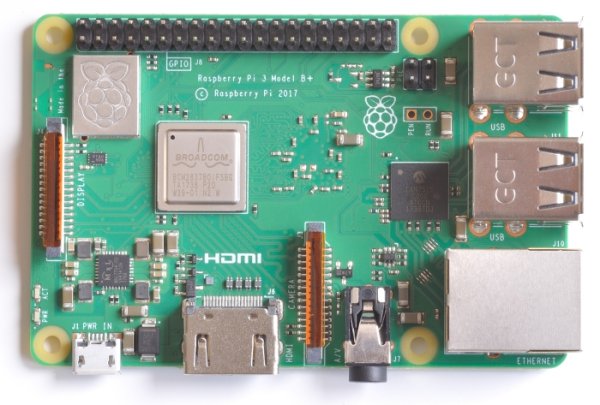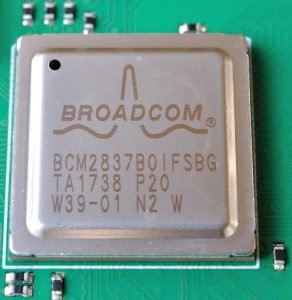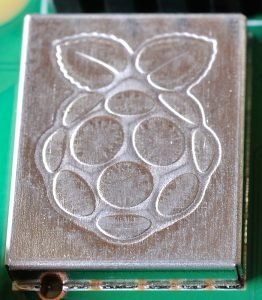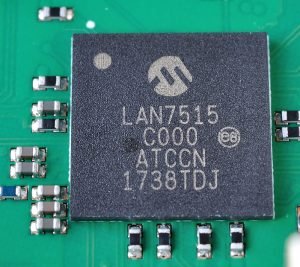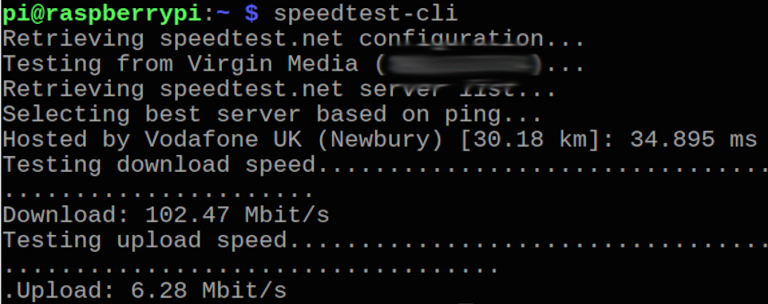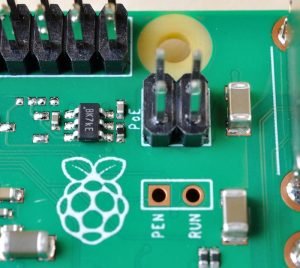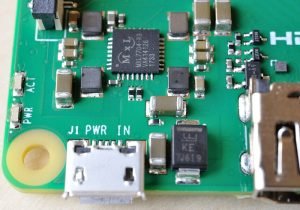It’s Pi day (if you do dates in the illogical MM/DD/YY format) so Raspberry Pi is releasing a new version of the Pi 3B. It’s called the 3B+, which is logical because it has more to offer than the 3B and is also in keeping with previous Pi naming conventions. It contains several incremental improvements, but taken together they provide a substantial upgrade in performance with a faster processor, addition of 5GHz wifi and 330Mbit ethernet and PoE. More detail further down. Here’s the new board…
Raspberry Pi 3B+
New Chip BCM2837B0 1.4GHz
Probably the most significant change is that there’s a new, enhanced version of the silicon. The new chip is the BCM2837B0, which has been tweaked to improve the power supply to the ARM cores. This means they can be clocked at 1.4 GHz (previously 1.2GHz) – a 16.7% increase.
While messing with the silicon, it was decided to add a metallic heat spreader and enhance the PCB to assist heat dissipation. This should help maintain higher clock speeds before throttling kicks in.
BCM2837B0 with heat spreader
802.11ac Wireless Support
The wireless ‘department’ has received a substantial makeover…
- It uses the Cypress 43455 “Single-Chip 5G WiFi IEEE 802.11ac MAC/Baseband/ Radio with Integrated Bluetooth 4.2 and FM Receiver” (FM Receiver not connected)
- The ceramic antenna has been substituted for a Proant resonant cavity antenna (as used on the Pi Zero W)
- The wireless/Bluetooth components have been enclosed in a metallised can
- 802.11ac is now supported, which means the Pi can do WiFi at 5 GHz as well as 2.4 GHz
You may remember when the Pi Zero W came out last year that the unlikely looking ‘vacuum cleaner nozzle’ shaped keepout in the PCB was the new antenna. This design performs better than the ceramic antenna from the Pi3B, so it’s been incorporated into the 3B+. You can see in the first close-up shot (click to enlarge) that there are 4 tiny capacitors incorporated into this antenna design. The two capacitors in the middle of the triangular cutout were not in the same position on the Pi Zero W, so the design has been tweaked for the 3B+.
Proant resonant cavity antenna (underside)
The wireless and Bluetooth components are now inside a metallised can. This component group has been FCC-approved as a module, which means if you incorporate a Pi3B+ into a product, wireless/BT transmission doesn’t require any further certification. The can also has the Raspberry Pi logo embossed on it, which is a rather nice touch…
Metallised can with Pi logo surrounds the WiFi/BT components
The Pi3B+ 802.11ac at 5 GHz has up to 100 Mbit performance. If you operate in a busy wifi environment, switching to 5 GHz can give some significant improvements. It’s always good to have choices.
Base-1000 Ethernet
The Pi 3B+ uses a Microchip LAN7515 chip for ethernet and USB 2.0 hub. So it can take advantage of a Gigbit ethernet connection, but because of USB 2.0 limitations, its maximum throughput is 330 Mbit.
Microship LAN7515 Gigabit ethernet and USB 2.0 Hub chip
This is still a big performance hike and will be plenty for most applications. My broadband is 100 Mbit, so the Pi3B+ is now able to fully utilise that speed. With the older Pi3B I could get a maximum speed of around 60 Mbit.
Internet speed test on 100 MBit connection with Pi 3B+
My router only has one Gigabit port, so I was unable to do a fair test of the ‘internal network’ speed, which I would expect to be at or close to the quoted 330 MBit.
The Gigabit ethernet chip uses more power than a 100-Base-T, but there will be a facility to switch this off to save power if not needed.
Overall the Pi3B+ uses about 170-200 mA more than the Pi3B. I’ll do a more in-depth post with power measurements in a few days.
PoE Connector Added
While we’re on the subject of ethernet, there’s a new header connector (labelled PoE) which attaches to another new official Raspberry Pi product – a power over ethernet board. This board will be available in a few weeks. If you have a compatible system, or a power injector, you’ll be able to power your Pi over the ethernet connection. This is really useful for remote applications where you only want to run a single cable – e.g. security camera.
Power over Ethernet connector
Power Circuit Tidy Up
The power circuit has been improved. In fact a new power management unit (PMU) has been developed which maximises performance and costs less to produce, enabling other design enhancements to the Pi3B+ while keeping the same price point.
New power circuitry
Component Count Reduction
The Raspberry Pi 3B+ has ~30 fewer components than the 3B, which means less components to pick and place in manufacture, therefore lower manufacturing cost. This also helps keep the product at the same price while making it ever better.
Processor Speed Test
Using the same multi-threading Python scripts I’ve used since Pi2 came out (find them here on GitHub) I compared the 3B+ with a Pi3B. In case you don’t remember or never saw it, these scripts take the Scrabble word list and sort it into letter order. It’s a huge list of something like 160,000 words, so it’s quite a nice processing task to throw at a CPU. You can tell the Pi to do it multiple times simultaneously, which makes it use multiple cores.
Results
Pi3B+ 4.95, 4.95, 5.01, 5.09 s average = 5.0 s
Pi3B 5.73, 5.73, 5.78, 5.87 s average = 5.755 s
You could either say the Pi3B+ was 13.12% faster or you could say the Pi3B was 15.1% slower, depending on which way round you do your sums.
Either way – in a real-world test, it’s not far from the expected 16.7% increase due to the faster clock speed.
Specifications
Silicon
- New BCM2837B0 chip
- Quad-core 64-bit ARM cortex A53 CPU
- Clocked at 1.4GHz
- ~16% faster than Pi 3B
- 400MHz VideoCore IV GPU
- 1GB LPDDR2-900 SDRAM
- Cypress 43455 chip for wireless and Bluetooth
- 802.11ac Wireless LAN
- Bluetooth 4.2
Connectivity
- 26 GPIO ports in the standard 40-pin Pi configuration
- 4 USB 2 ports
- 1000 Base-T ethernet (max speed 330 Mbit)
- DSI port
- CSI port
- 4-pole composite video/audio
- HDMI 1.4
Power
- Micro-usb power in
- 2.5 Amp supply recommended
Overall Summary
This is a very welcome upgrade with faster and better WiFi, much faster ethernet, 16% faster processor speed, the possibility of PoE and all for now traditional “$35 + shipping and local taxes” Raspberry Pi model B price point.
Several incremental upgrades contribute to a very worthwhile board update. Well done Raspberry Pi engineers.
Read More info….
New Raspberry Pi model 3B+ 1.4 GHz, 330Mbit Ethernet, 802.11ac, PoE


